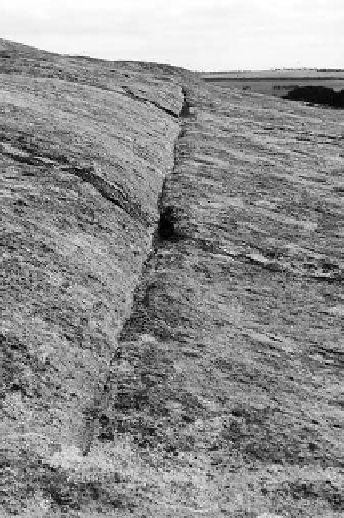Geology Reference
In-Depth Information
(a)
(b)
Figure 9.16.
(a) Roughly linear depression lacking apparent fractures, Little Wudinna Hill, Eyre Peninsula,
South Australia, and (b) nearby Kluftkarren in the same orientation.
That mechanical abrasion is effective in the erosion of the beds and sidewalls of channels is sug-
gested first, by the volume and velocity of water that, charged with mineral particles and other
flotsam and jetsam, courses along the channel, if only from time to time; second, by the develop-
ment of small pot-holes in some localities; third, by the sinuous or meandrine form of some gut-
ters (
Fig. 9.14c)
,
which implies lateral erosion of the sidewalls; and last by the basal widening of
some bedrock channels, though duration of wetting also plays a part in this development.
Channels excavated in granite in periglacial, recently deglaciated, areas may have been eroded by
subglacial streams flowing under high hydraulic pressure, with mechanical abrasion both con-
tributing significantly to the end result.
On the other hand, the development of pitted surfaces in channel beds argues the effectiveness
of chemical weathering there, and suggests that standing or retained moisture (depending on
slope) can cause the gradual loosening and detachment of the rock particles, and their subsequent
evacuation by the occasional flows of water. The flask-shaped cross-sections displayed by some
channels may be due to longer wetting, and hence more effective weathering of the bed.
As with rock basins, there is clear evidence that some gutters are initiated at the weathering
front. At several sites on Eyre Peninsula, South Australia, gutters have been traced into the natural
subsurface. On both Dumonte and Crowder rocks, in the Minnipa-Wudinna district, what are sep-
arate channels on the exposed low dome converge and coalesce beneath the natural soil level, just
as do streams and channels on exposed surfaces (
Fig. 9.17)
.
The regolith also is affected by runoff
from the nearby rock surfaces. Piping and even sinkholes and elongated subsidence depressions
are developed in various granitic areas of the Iberian Peninsula.
The reason for such subsurface extensions of channels is that water pours into the regolith from
the domes and platforms but is concentrated in the areas where runnels and gutters debouch from
the hills on to the plains. Here the weathering front is lowered relative to the rest of the interface
between altered and fresh rock. Shallow channels are formed aligned normal to the edge of the
outcrop. Where such piedmont zones have been exposed, pitting is markedly more pronounced in
these linear zones than on the rest of the weathering front. Some incipient or subsurface channels



